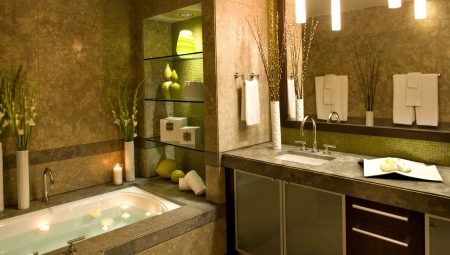Niche is an interesting architectural solution. In modern design, such elements can combine practicality and beauty. Equipping a niche in the bathroom, home owners can not only rationally use the space, but also give the interior a bright personality.

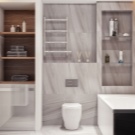

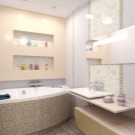
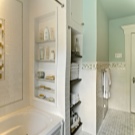

Features
This structural element appeared in ancient times. Small recesses were specially made in the walls. They placed statuettes depicting the gods, and other religious objects. Today, niches are also used to accommodate small but important things. They successfully replace the usual shelves, shelves and nightstands. At the same time, the room remains free from bulky furniture. This moment is especially important for bathrooms, because such rooms usually do not differ in large sizes.
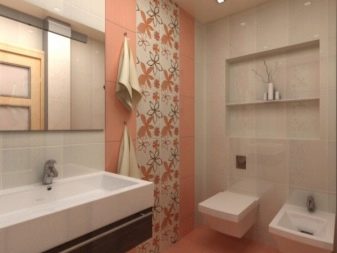

Sometimes the recesses in the walls are provided by the design project and are created specifically. In other cases, depressions are formed due to certain repairs. For example, when disguising the installation system, a small plasterboard wall is constructed. You can use this and make a spectacular decorative “shelf” in the upper part of the structure.
The same situations arise when hiding water pipes going to the bathroom, various utilities. As a result, you get Stylish and neat interior with a functional built-in storage system. And if you competently beat the resulting grooves in the walls, then they will become a real highlight of the room.
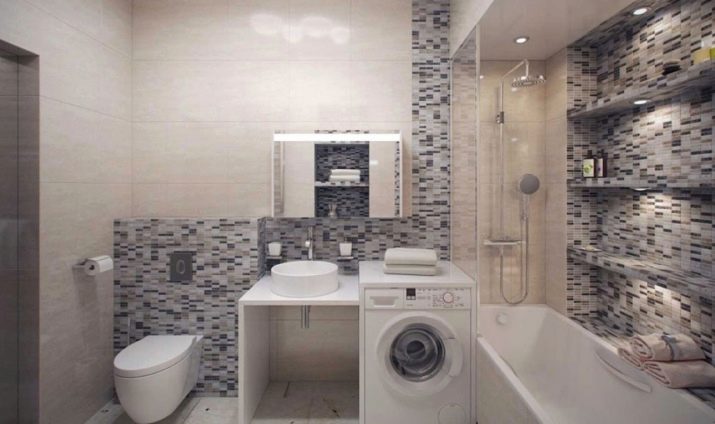
Advantages and disadvantages
The advantages of such designs are numerous.
- Practicality. You get compartments that contain many of the items you need in the bathroom.
- Convenience. Unlike hinged shelves and cabinets, the recess does not stand out at the level of the wall, which means it does not interfere with freedom of movement. You will not accidentally touch it with your hand, you will not be able to hit it.
- The feeling of spaciousness. The recesses seem a natural extension of the walls. Despite the fact that some objects may be in niches, the feeling of a complete lack of furniture remains. This is especially valuable for interiors in the style of minimalism.
- Beauty. Usually niches are decorated with the same materials that are used for decoration. Therefore, they look very aesthetically pleasing. If in addition to decorate the recesses (for example, backlight), the attractiveness of these places will increase.
- Space saving. In small bathrooms, every meter counts. Therefore, the ability to replace furniture with recesses in the walls becomes a real salvation.

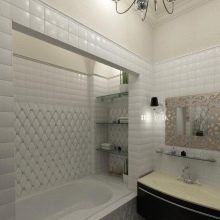
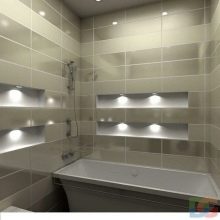
However, it is worth noting the disadvantages of such a solution.
- Limited functionality. Niches are intended only for small and light objects. In addition, they are not protected by anything, unlike, for example, lockers. You will not be able to store towels or clothes in the recess for a long time, as dust and, in some cases, drops of water will fall on them.
- The complexity of dismantling. If you can remove and move the shelf at any time to another place, then you won’t be able to move the niche. Will have to make repairs, partially changing the decoration of the walls.
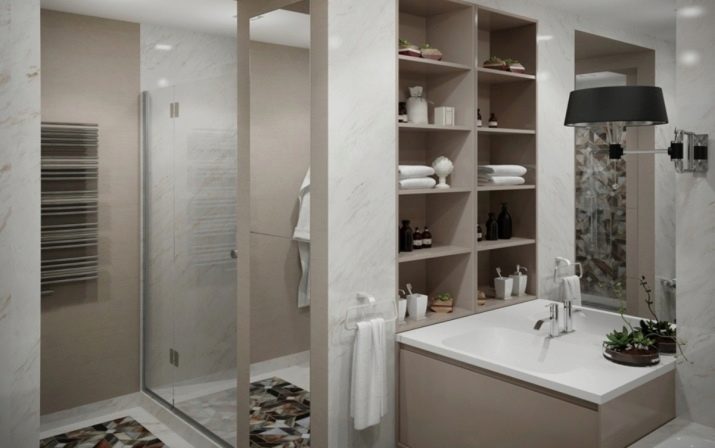

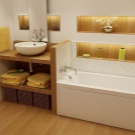
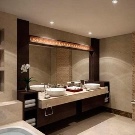
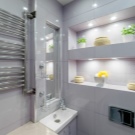
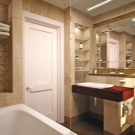
Types of accommodation
Niches can be placed in different parts of the bathroom. However, some options are most common.
- In the bath area. Such recesses usually have a practical purpose. They put detergents and cosmetics, hygiene items. It is convenient to put a bath towel on such a “shelf” before taking a shower or bath. This allows you to immediately wipe yourself and not leave the bathtub wet. Sometimes the recesses in the walls are used for aroma candles or souvenirs. Those who like to soak in the fluffy foam, at the same time enjoy the beauty of the decor that adorns the area for the adoption of water procedures.
Typically, niches are made at the end of the wall that the bath adjoins. As a rule, these are several identical recesses located under each other or one vertical, divided by partitions. Sometimes, to create a structural element, a long wall is chosen along which the bathtub stands. In this case, you can show imagination. It can be one long recess in the wall. You can make two niches that are next to each other on the same level, or under each other. A diagonal arrangement is also possible.
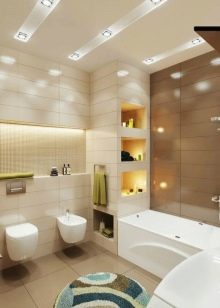
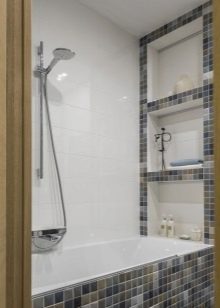
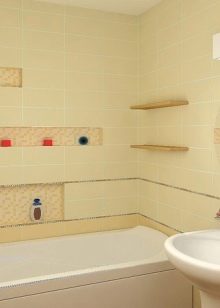
- In the shower. Here, the recess in the wall also performs the function of storing bath accessories. The shape, size and location can be any. Often used both horizontal and vertical structures. In some cases, a small “shelf” is preferred, and sometimes a recess occupies two or even all three walls. It all depends on the design idea and the needs of users.
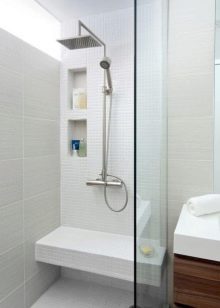
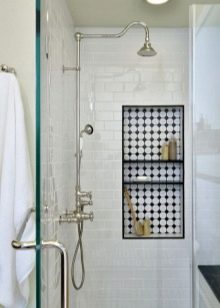
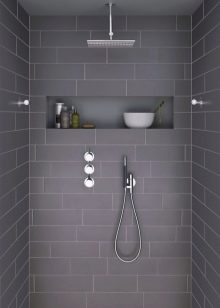
- Over the toilet. The recess in the wall above the toilet with installation can be used in different ways. Often it plays the role of a decorative element, being a stand for souvenirs. However, if there is not enough space in the bathroom, a storage place can be arranged here, for example, for household chemicals. There are also several options in this case. It can be one big niche or several shelves. Often, a hinged closed cabinet is located above the recess.
This solution is very practical. The main thing is to correctly calculate the size of the furniture so that its facade is on the same level with the wall that hides the installation.
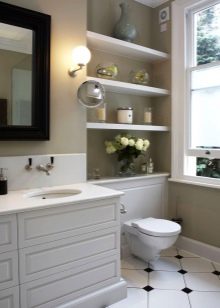
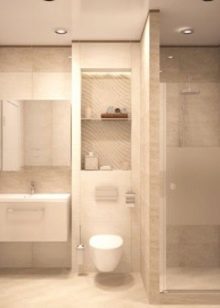
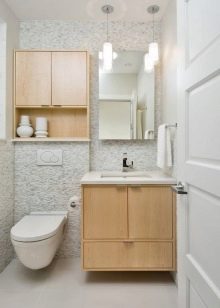
- Near the washbasin. Built-in storage near the sink can be very useful. If you want to hang a mirror without shelves and a cabinet adjacent to the washbasin, you can put all your daily care products in a niche on a perpendicular wall.You can also place a towel hanger in the recess.
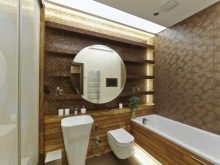
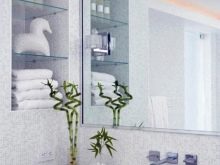
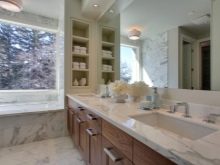
- In other places. If the room is spacious, you can use niches as an opportunity to decorate it with various accessories. In this case, the recesses can be located in any place convenient for you. Although, of course, it is advisable to draw up a project before the repair in order to assess the correctness of the selected places.

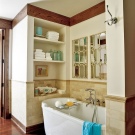
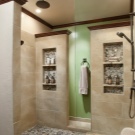

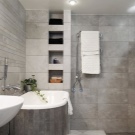
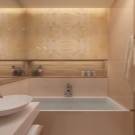
Filling options
As already mentioned, the niches in the bathroom are almost universal. They are great for storing shampoos, shower gels, scrubs, washcloths and other things that you might need in the shower.
With such objects, it is logical to fill in the recesses located next to the bathroom or in the shower.
Usually, they are finished with ceramic tiles, like the rest of the wall. Therefore, they are not afraid of splashing water.
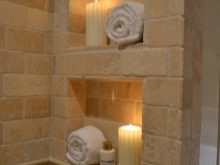
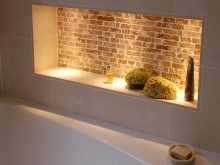
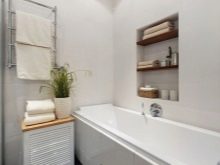
If the niche is near the sink, it will be convenient to store means for washing, shaving, combs, hairpins, cosmetics, and all that may be needed for daily morning “rituals”.
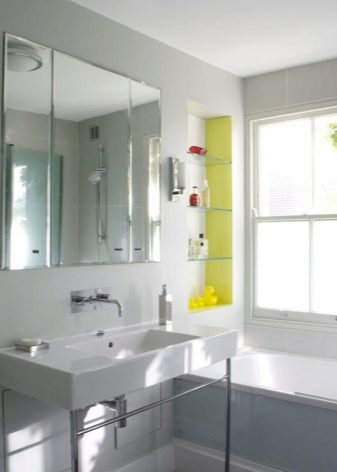
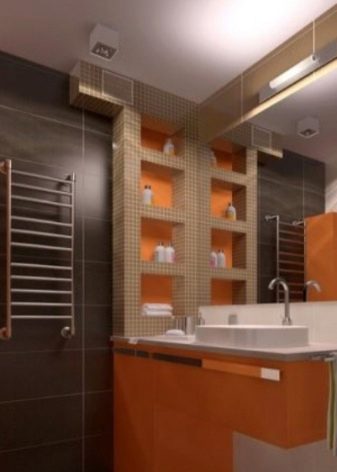
If the recesses are located in an arbitrary place, you can decorate them with pots of hygrophilous plants. You can also arrange photos in glass frames, decorative vases, beautiful candles. Large shells and interesting stones will look appropriate in the bathroom.
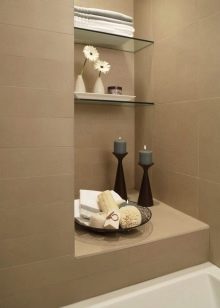
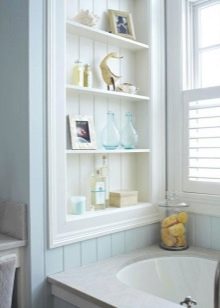
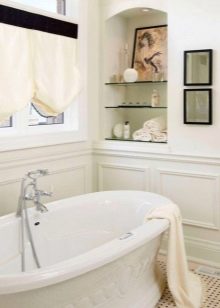
If the niche is provided for by the house construction project and is very large, can put a washing machine in it. This will allow to remove household appliances away so that it does not interfere with freedom of movement. Also thanks to this, the room will seem more spacious and tidy.
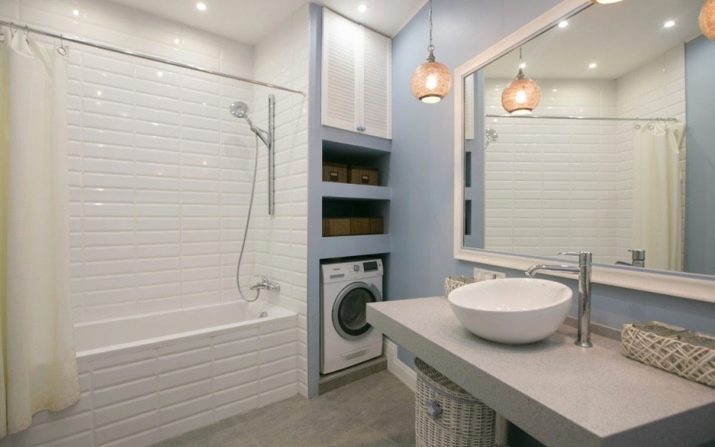
The bath itself, placed in the recess, is no less a good solution. So the zone of acceptance of water procedures will be visually separated from the main area of the room. As a result, you get a stylish and aesthetic interior.
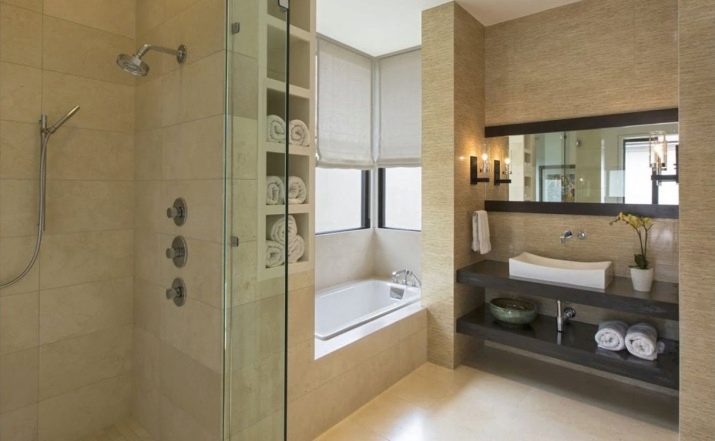
You can put a sink in the recess. This is a fairly common option. Side walls protect plumbing from external influences and create a sense of order and perfect organization of space.
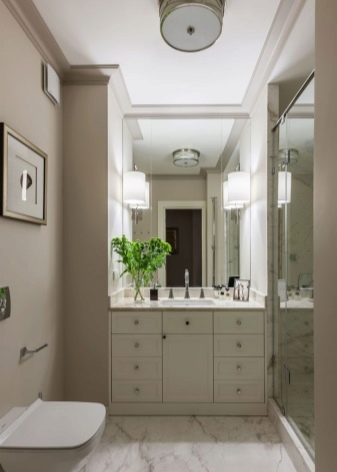
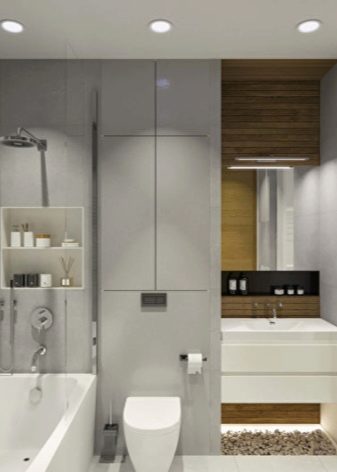
Mirror in a niche - a successful design move. It can be a mirror cloth located above the sink. Here, the reflective element is a traditional part of the wash basin.
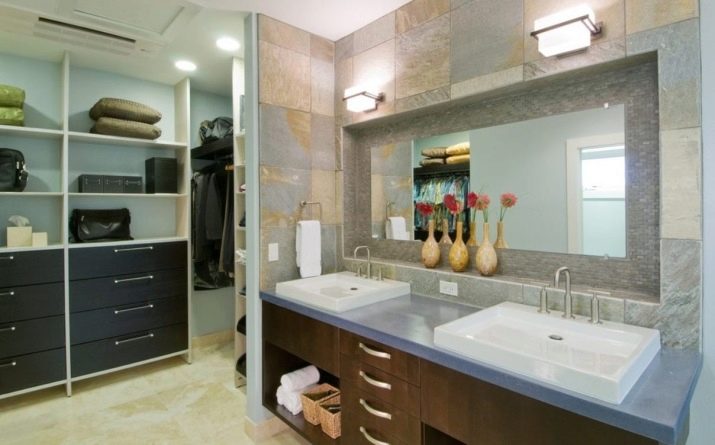
You can place a small mirror over a shelf in the shower or over the bathroom. Such a solution will appeal to women who make face masks, lying in a warm foam, or wash off their makeup at the same time as taking a shower. Also, a mirror can be an independent element located anywhere in the bathroom. In this case, the subject becomes a spectacular accent that transforms the space, filling it with light, volume and depth.
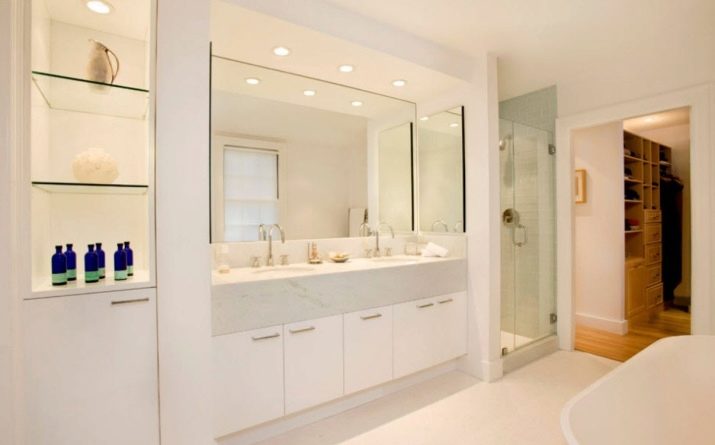
Materials
If a niche already exists, it remains only to choose a way to finish it. If the decorative opening is still at the project stage, it is necessary to create an artificial wall from materials suitable for this.
The best option is moisture-proof drywall. Also sometimes use plywood, particleboard, durable plastic.
If you decide to make a niche from drywall, you can implement any design ideas. You will get a perfectly smooth surface, you can give it any shape (rectangle, circle, square, arch). Also for work, you will need a profile made of galvanized metal to create a crate. Fastening occurs with the help of screws.
You can finish the recess with ceramic tiles, mosaics, plastic panels. If the recess is not in contact with water, a decorative plaster suitable for bathrooms can be used. You can also simply paint the design in the desired color.
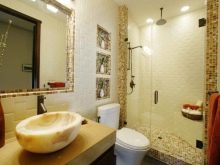
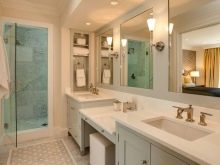
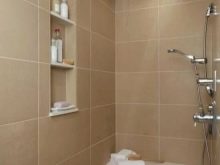
Dimensions
The depth, width and height of the artificially created niche is determined based on the needs of users, the location of the element and the dimensions of the bathroom. Using this architectural technique, you can also visually change the proportions of the room. If the main problem is a low ceiling, you can create a vertical recess that visually stretches the space.


A narrow and cramped room can be visually expanded thanks to horizontal recesses.
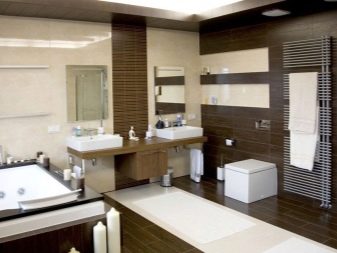
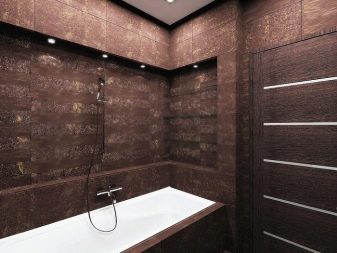
If you want to make several niches for different categories of objects, but there is not enough space, you can make one large recess and divide it into parts using thin partitions made of wood, plastic or glass.
Of course, wooden parts must be treated with a special moisture-proofing compound.
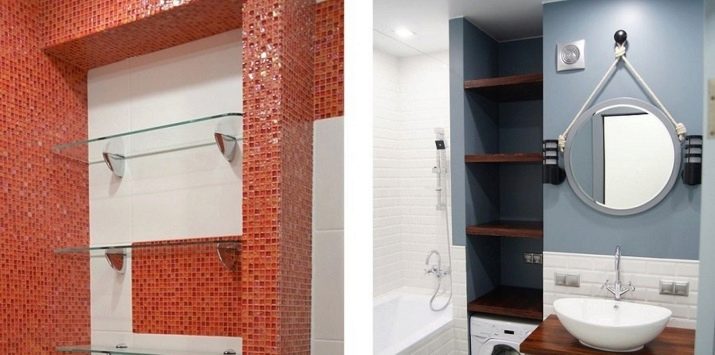
How to design beautifully?
- Shelves. Tall structures are divided into several compartments by shelves, not only for practical reasons. The material chosen for the dividers can emphasize the interior features of the room. Wooden elements can complement other objects of the same texture and color in the bathroom. It will be interesting to look at the contrasting design (for example, shelves of wenge color against the background of light walls). Glass will make the design light and airy. This design will appeal to connoisseurs of sophisticated design.
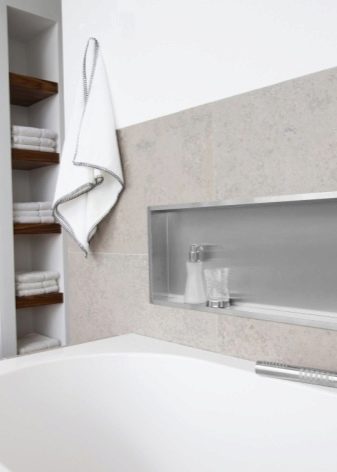
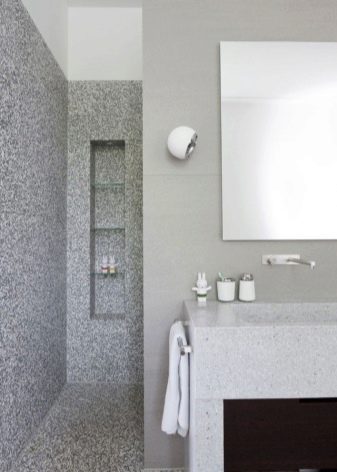
- Backlight Lighting design is an important point. First of all, highlighting will simplify the search for an object located in a recess. In addition, it will turn a niche into a real bathroom decoration. A soft glow will highlight the bends of the walls, emphasizing the originality of the design. It will also present the contents of niches in a favorable perspective. Even ordinary bottles with detergents will look in such a frame “expensive” and presentable. If you decorate the notches with decor items, the effect will be even more impressive.
Illumination is usually realized with the help of LED strip located around the perimeter, or spotlights, built into the upper or side parts of the structure. In this case, the backlight can be either ordinary or color.
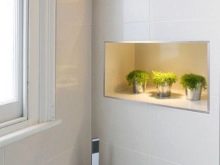
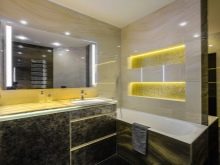
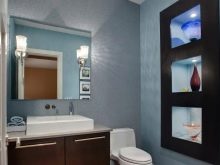
- Mosaic. A full mosaic finish of the area intended for water procedures is an expensive pleasure. However, you can go the other way, decorating the wall with ordinary tiles, and mosaics - only recesses in it.
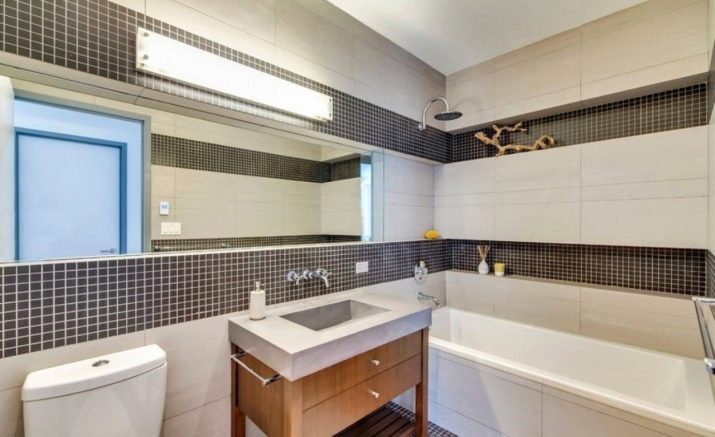
- Disguise. If a large niche is filled with a washing machine, other household appliances or other things that you would like to hide from prying eyes, you can close it. To do this, you can use blinds or special doors.

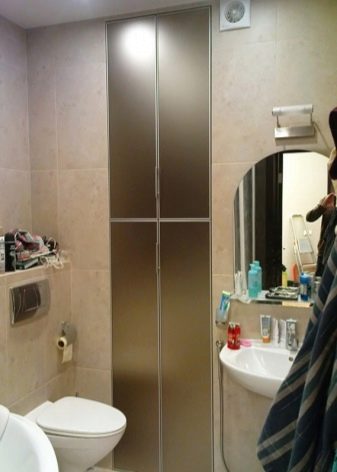
Examples in the interior
- A good example of the use of niches in the interior of the bathroom. One is in the shower, the second is next to the bath, the third is under the sink. Each depression performs its function, while maintaining harmony and unity of style.
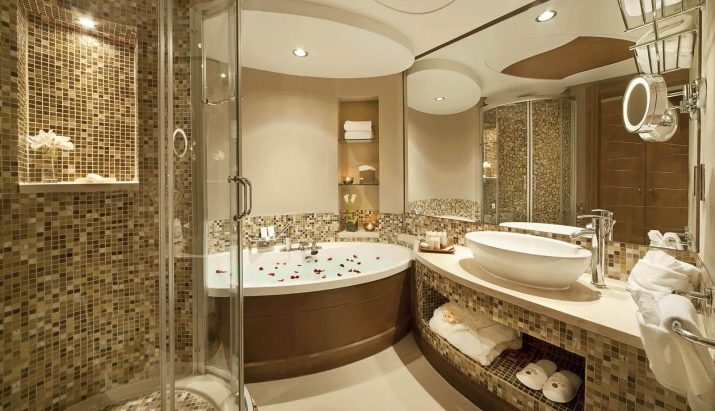
- The large niche is beautifully divided into two parts with the help of a wooden shelf. Spectacular design technique supporting the concept of a contrasting interior.
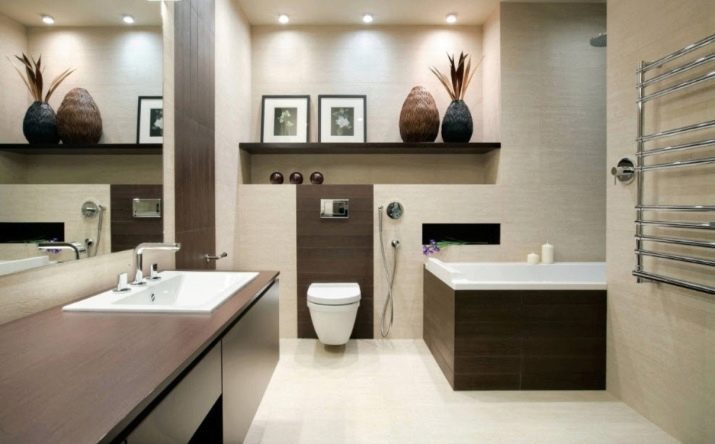
- Even small shelves over the toilet with installation can be very useful.

- Square recesses in the wall look more original than the usual rectangular options. A great way to make an interior special.
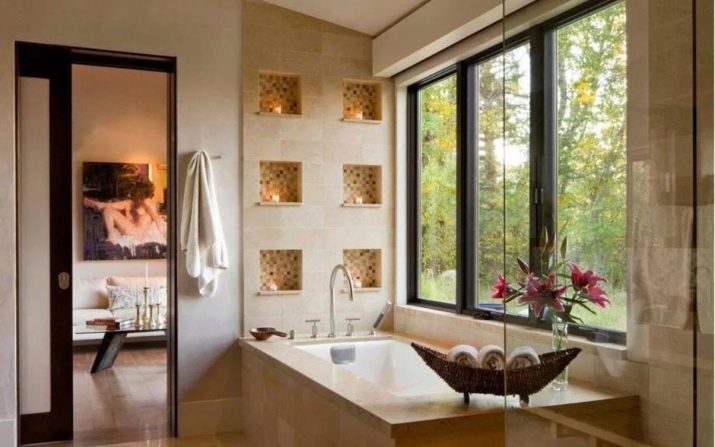
- The niche formed between the shower and sink is an excellent opportunity to equip a convenient storage system.

You will learn more about niches in the bathroom by watching the following video.
